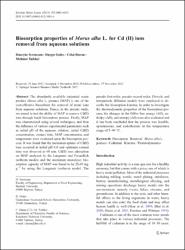Biosorption properties of Morus alba L. for Cd (II) ions removal from aqueous solutions
Erişim
info:eu-repo/semantics/closedAccessTarih
2013Erişim
info:eu-repo/semantics/closedAccessÜst veri
Tüm öğe kaydını gösterKünye
H. Serencam, D. Ozdes, C. Duran, M. Tufekci, “Biosorption properties of Morus alba L. for Cd (II) ions removal from aqueous solutions”, Environmental Monitoring and Assessment, 185, 6003-6011 (2013).Özet
The abundantly available industrial waste product Morus alba L. pomace (MAP) is one of the cost-effective biosorbent for removal of metal ions from aqueous solutions. Hence, in the present study, we aimed to test the ability of MAP to remove Cd(II) ions through batch biosorption process. Firstly, MAP was characterized using several techniques, and then the influence of various experimental parameters such as initial pH of the aqueous solution, initial Cd(II) concentration, contact time, MAP concentration, and temperature were evaluated upon the biosorption process. It was found that the maximum uptake of Cd(II) ions occurred at initial pH 6.0 and optimum contact time was observed as 60 min. Cd(II) ions adsorption on MAP analyzed by the Langmuir and Freundlich isotherm models and the maximum monolayer biosorption capacity of MAP was found to be 21.69 mg g(-1) by using the Langmuir isotherm model. The pseudo-first-order, pseudo-second-order, Elovich, and intraparticle diffusion models were employed to describe the biosorption kinetics. In order to investigate the thermodynamic properties of the biosorption process, the changes in the Gibbs free energy (a dagger G), enthalpy (a dagger H), and entropy (a dagger S) were also evaluated and it has been concluded that the process was feasible, spontaneous, and endothermic in the temperature range of 5-40 A degrees C.


















